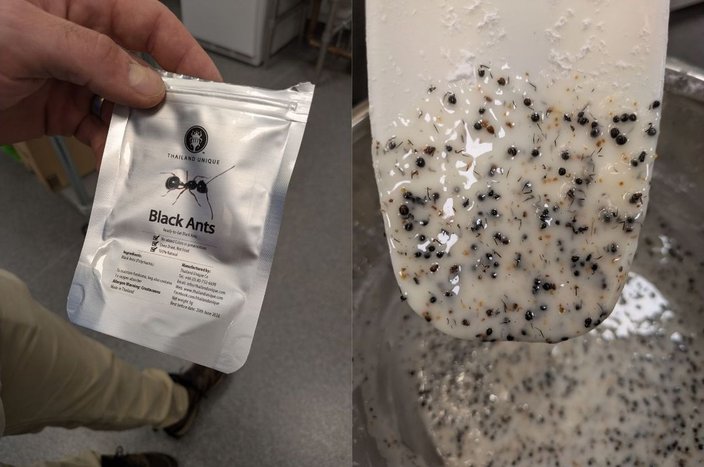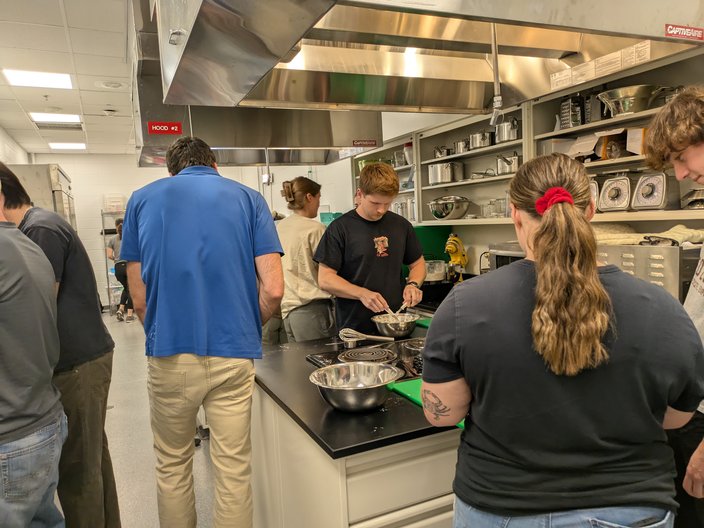For his new class at the University of Delaware, professor Michael Crossley wanted to show students the benefits of eating insects, from ground-up crickets to chili paste infused with giant water bugs.
"When you think about eating insects, the image that may come to mind is grabbing a fly out of the air and sticking it in your mouth," Crossley said. "That's absolutely not what we're talking about, any more than saying we're going to eat chicken and going and taking a bite of a chicken in a field."
MORE: With flashlights and buckets, volunteers 'listen for the hops' to save frogs and toads in Roxborough
For the spring semester, 30 students added insects as food to their course load. Twice a week for 80 minutes, they attended lectures about entomology and the role bugs play in the world's food system. Outside the classroom, they were tasked with raising insects in their homes. And during five class sessions, they cooked a dish that incorporated bugs — legs, wings, antennae and all, in some cases.
Similar to a high school home economics class, the students broke up into groups of three or four and assigned a head chef, sous chef and dishwasher each session. Once they were given the recipe, the head chefs met to create a plan and follow the recipe. The syllabus featured a crunchy granola made with cricket flour, vanilla berry smoothies with mealworm protein powder, a black bean chili with sago worms, a pasta salad with the water bug paste, and scones with black ants.
The scones and the chili both included whole bugs, but the rest were different types of ingredients to show the versatility of insects, Crossley said.
"People have been eating silkworm pupae for thousands of years, and they're cooking it in really elegant ways," Crossley said. "So it's absolutely not that weird, disgusting, strange thing."
Most of the recipes were written by Megan Bartley, a Ph.D. candidate in evolutionary ecology at the University of Utah who creates meals for the Natural History Museum of Utah's annual Bugfest event. After working as a professional chef for 22 years, Bartley gained an interest in wild foods and the role they play in different cultures. Eating insects is very common around the world, particularly in Indigenous cultures, she said, and it's only stigmatized in Eurocentric and Western societies.
"It's just kind of getting people to recognize that the yuck factor is something that's learned," Bartley said.
Developing a recipe with insects is similar to creating any other dish, Bartley said, but with several advantages. Bugs are great sources of protein, offering more grams per 100 grams than most meats, according to the National Institute of Health. They also contain healthy fats and low amounts of unhealthy fats — Bartley said she often has to add fat into recipes for taste, similar to cooking with wild game.
At the same time, insects also produce less carbon emissions than poultry, pork and beef, and use far less water. About 112 liters of water are required to produce a gram of beef, but only 23 liters are needed to produce a gram of insects for consumptions, the Guardian reported. In some cases, Bartley said, they're even water neutral. They also require less land and aerate the soil during cultivation.
However, in the United States, they tend to be less affordable than other sources of protein, as insects mostly need to be imported from other countries. But Bartley hopes that can change.
"There's just a stigma associated with it where you eat [insects] if you have to," Bartley said. "But it's getting to the point where it might also just be a good idea, not that we have to because of economic reasons, but also because of ecological reasons. So it would be more of a collective action than something born out of necessity."
 Michaela Althouse/PhillyVoice
Michaela Althouse/PhillyVoice
Students used dried ants in a scones recipe during the insects as food course. Right, a close-up of the ant-infused glaze for the pastries.
 Michaela Althouse/PhillyVoice
Michaela Althouse/PhillyVoice
Students and professor Michael Crossley work in the kitchen during one of the course's cooking days.
Crossley said he'll likely offer the course every other year unless demand is high. The class was full this spring, save for a few dropouts, and students had good reviews for its inaugural semester.
"I was definitely surprised with just how good things were," said Sam Truluck, a senior. "I didn't think I was going to be super grossed out or repulsed by anything, but I thought it was going to be average food with a bug in it. These have really shown that it doesn't have to be mid or bad if it has bugs on it."
Some students, especially those studying entomology, had experience eating bugs before coming to this class. But they said that the versatility in recipes and the tastes were a pleasant surprise, describing some of the bugs as lemony, nutty and earthy.
Senior Aidan Meister said that while eating insects still seems like a novelty, he hopes that with changes in public perception, there will eventually be more infrastructure in place to bring costs down and make it more of a normalized protein source.
Catherine Eberle, a senior wildlife ecology and conservation major, said she'll often talk with classmates about the recipes and get excited about what they're making. To them, eating insects feels normal after taking the course, but outside that group, family and friends don't view it in the same way.
"Just because there's a bad stigma, it doesn't mean it's going to taste bad," Eberle said. "Lobsters were once seen as poor people food, and now it's a delicacy. So if you just change your opinion on something and have an open mind with it, it could be a really great thing."
Have any thoughts?
Share your reaction or leave a quick response — we’d love to hear what you think!






